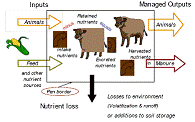Biological Systems Engineering, Department of

Department of Agricultural and Biological Systems Engineering: Presentations and White Papers
Date of this Version
7-2024
Document Type
Presentation
Citation
ASABE Annual International Meeting (Anaheim, California, United States: July 2024): Paper No. 2400385, 12 pages
American Society of Agricultural and Biological Engineers
Abstract
Sustainable irrigation methods maximize agricultural productivity in Northern African countries like Sudan. This project evaluates soil properties to develop optimized irrigation strategies for Sudan's arid and semi-arid climate. Assessing soil characteristics such as texture, infiltration rates, and nutrient content informs the selection of modern irrigation systems. Data from 3,192 locations, collected using GPS and ring infiltrometers for infiltration rates, alongside laboratory analyses for soil properties, were employed. A ranking system determined suitable irrigation systems for specific soil classes, considering factors like slope, wind, crop tolerance, available water capacity (AWC), drainage, germination, capital cost, labor cost, maintenance, and evapotranspiration (ET). The study evaluated the efficiency of three prevalent irrigation methods—center pivot, drip, and surface irrigation—across five soil types. Drip irrigation showed marked efficiency, ranging from 76% to 78% across three soil types, while Center Pivot Irrigation was optimal for Typic Haplsalids (gravelly) soil. Surface Irrigation consistently underperformed, with efficacy rates between 63% and 72%. Typic Haplsalids gravelly soil favored sprinkler irrigation, with 75% higher efficacy. Tailoring irrigation methods to specific soil types maximizes efficiency. Soil permeability variability emphasizes the need for tailored water management strategies, with subsurface irrigation posing challenges in coarser soils. Considering soil variability, ET, investment, and workforce expense when selecting irrigation methods is crucial for sustainable water management and efficiency. investment, and workforce expense when selecting irrigation methods is crucial for sustainable water management and efficiency.
Included in
African Studies Commons, Agricultural Science Commons, Agronomy and Crop Sciences Commons, Bioresource and Agricultural Engineering Commons, Soil Science Commons


Comments
Copyright 2024, ASABE. Used by permission